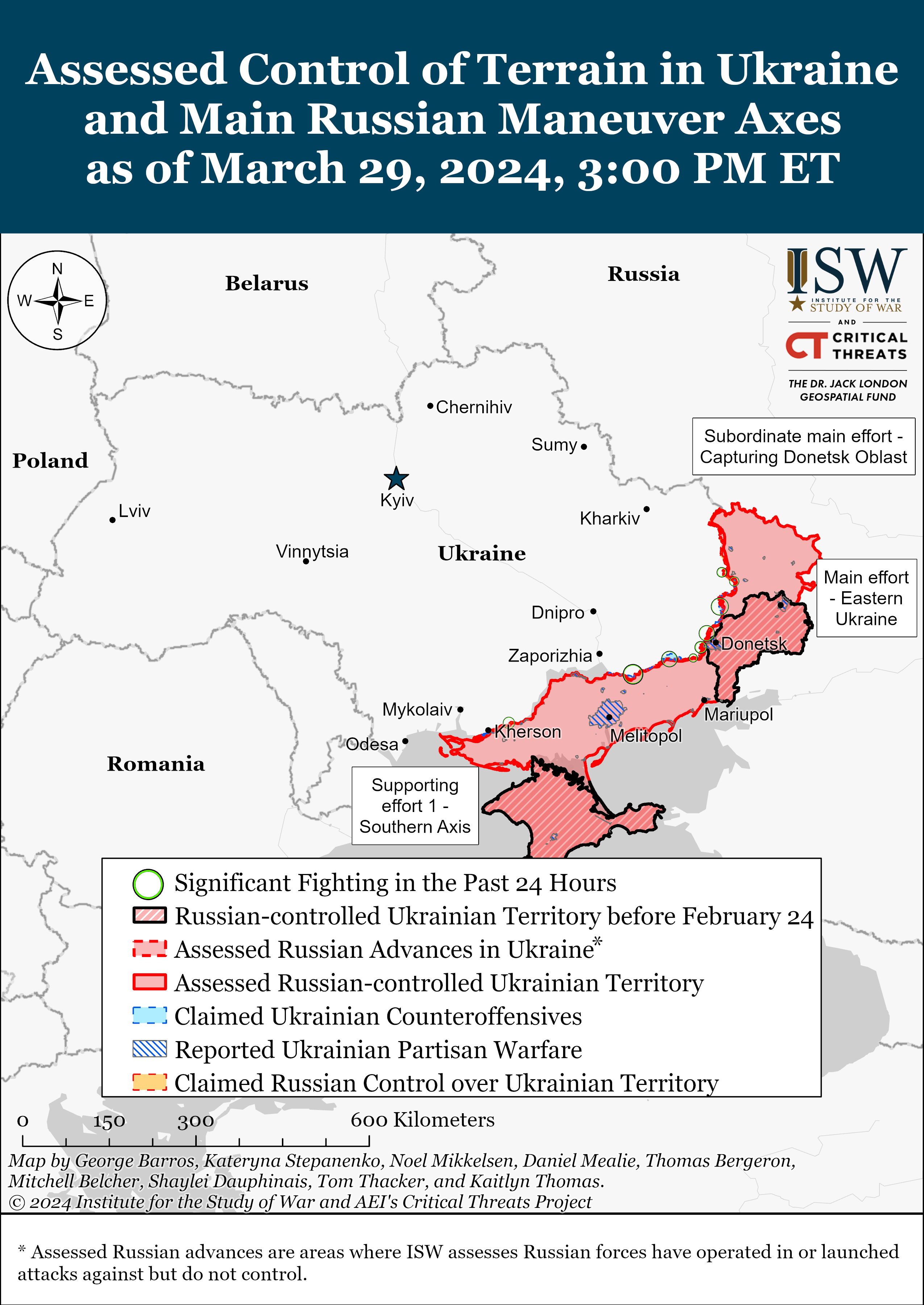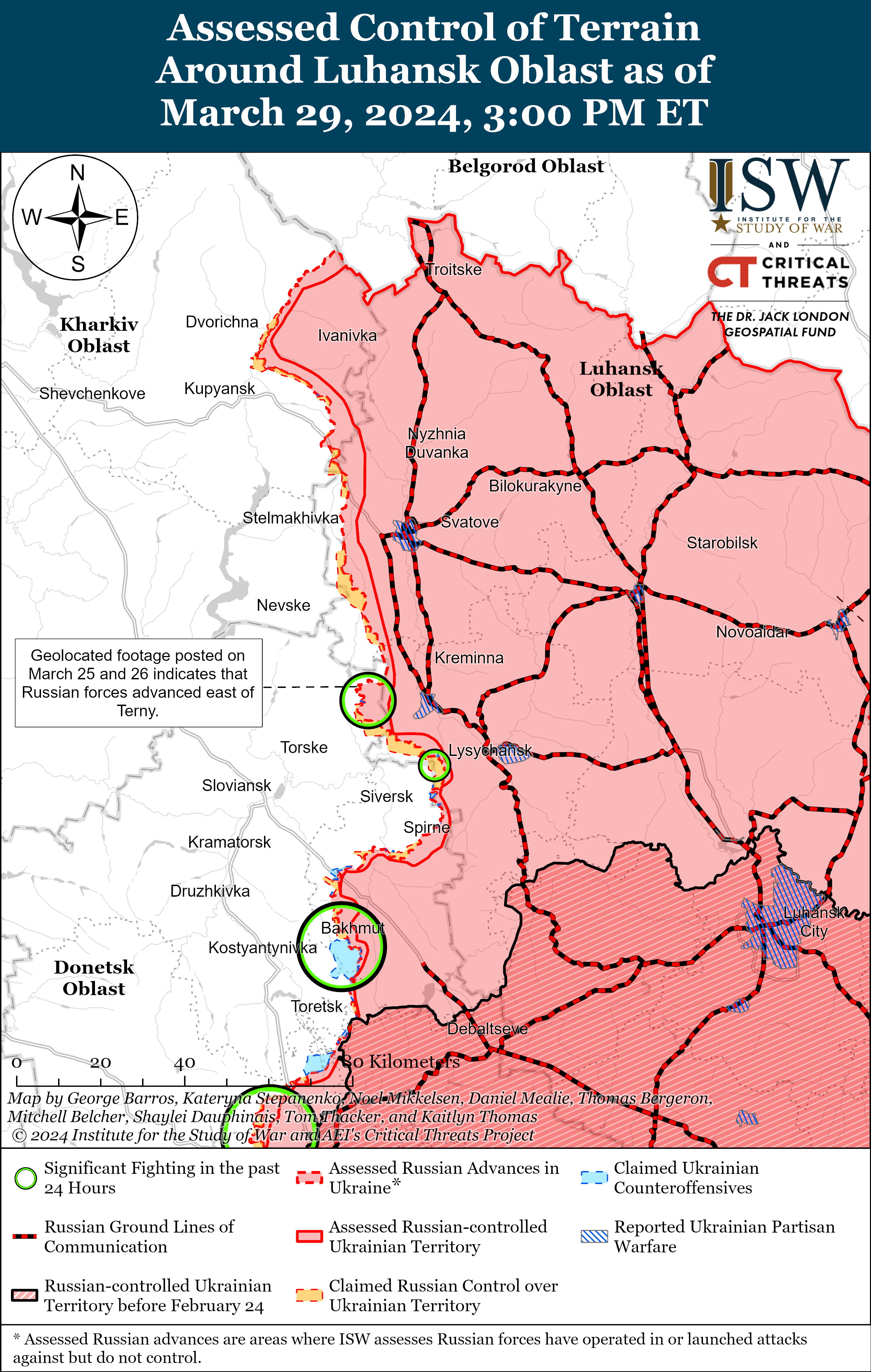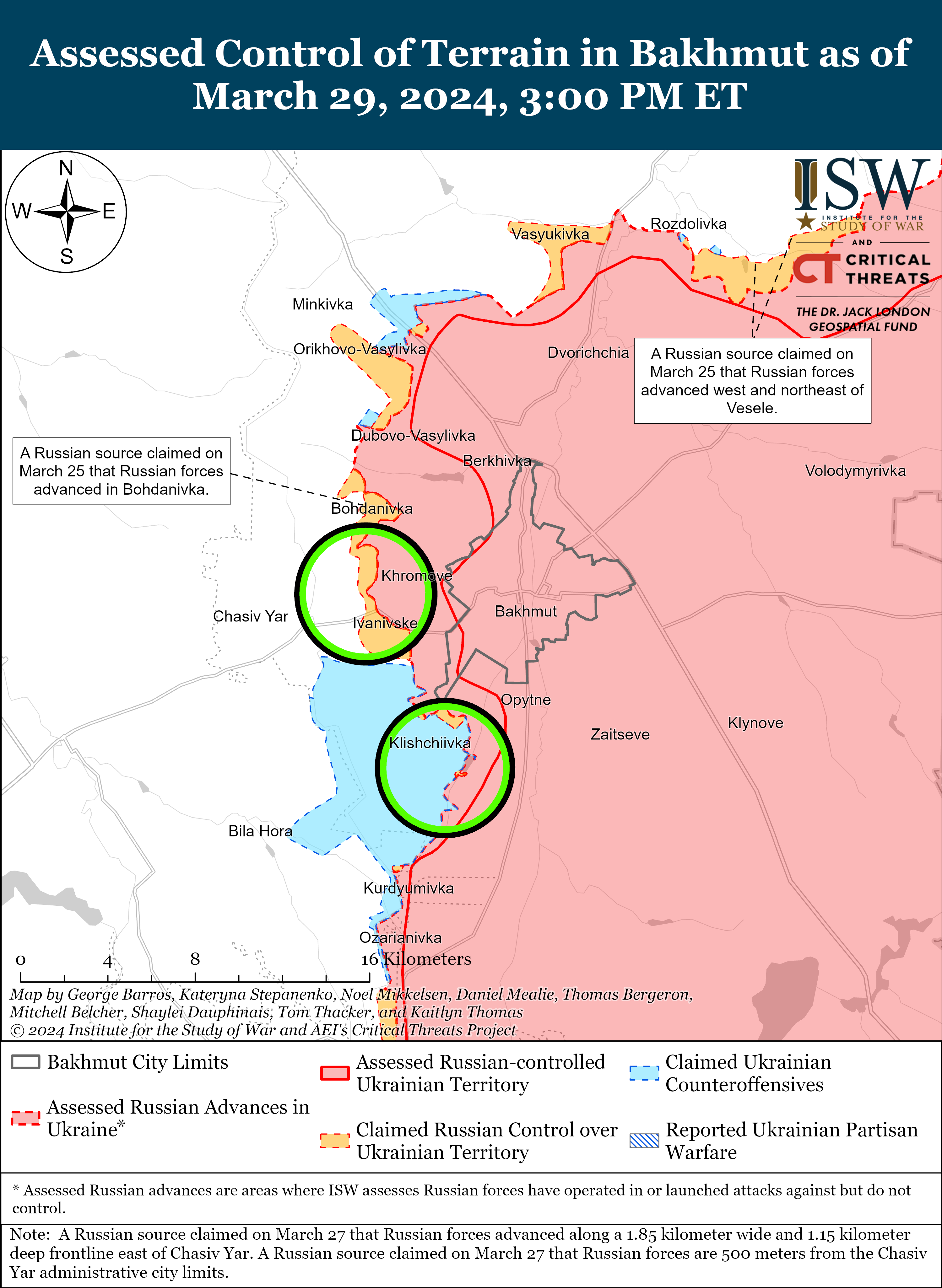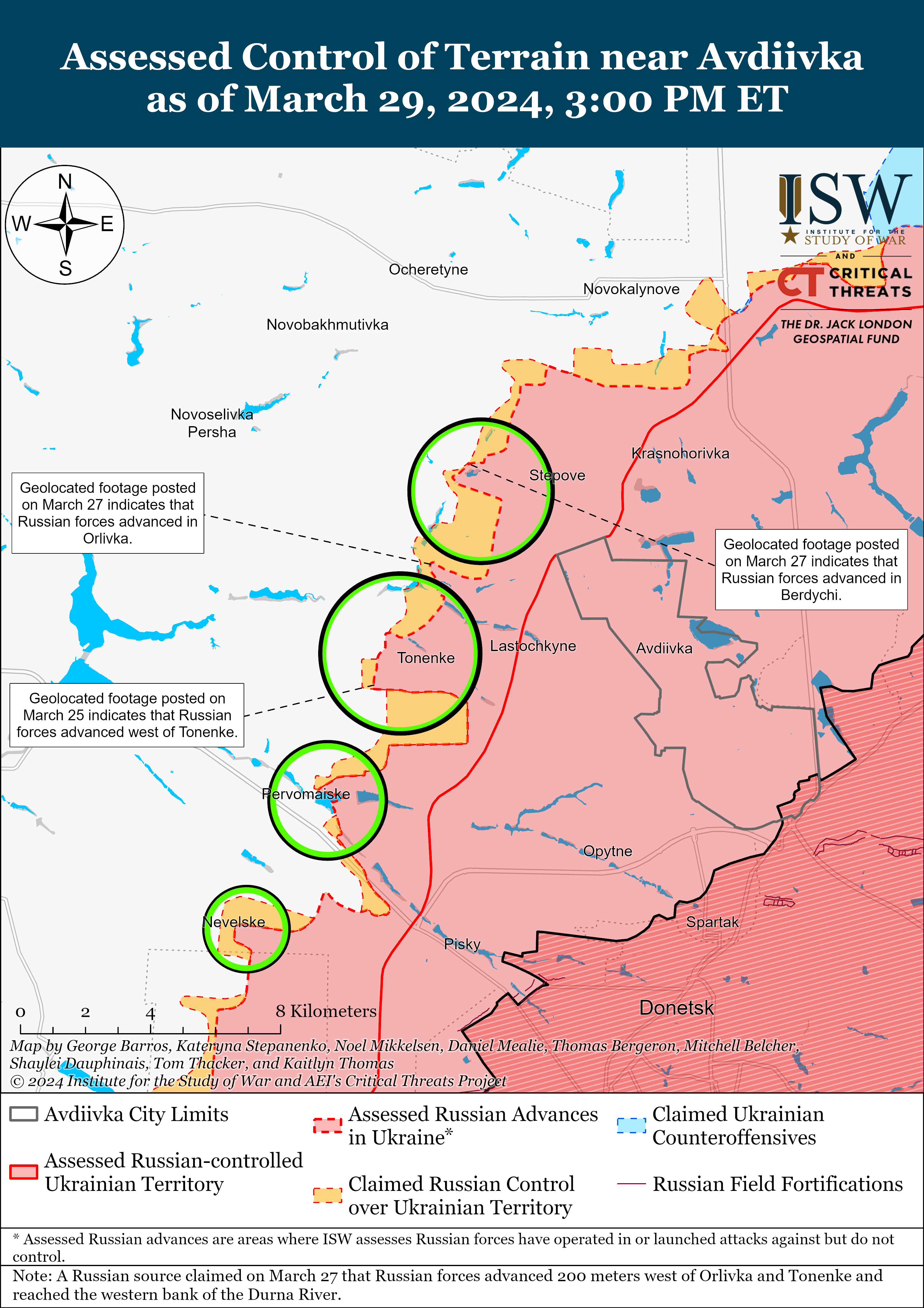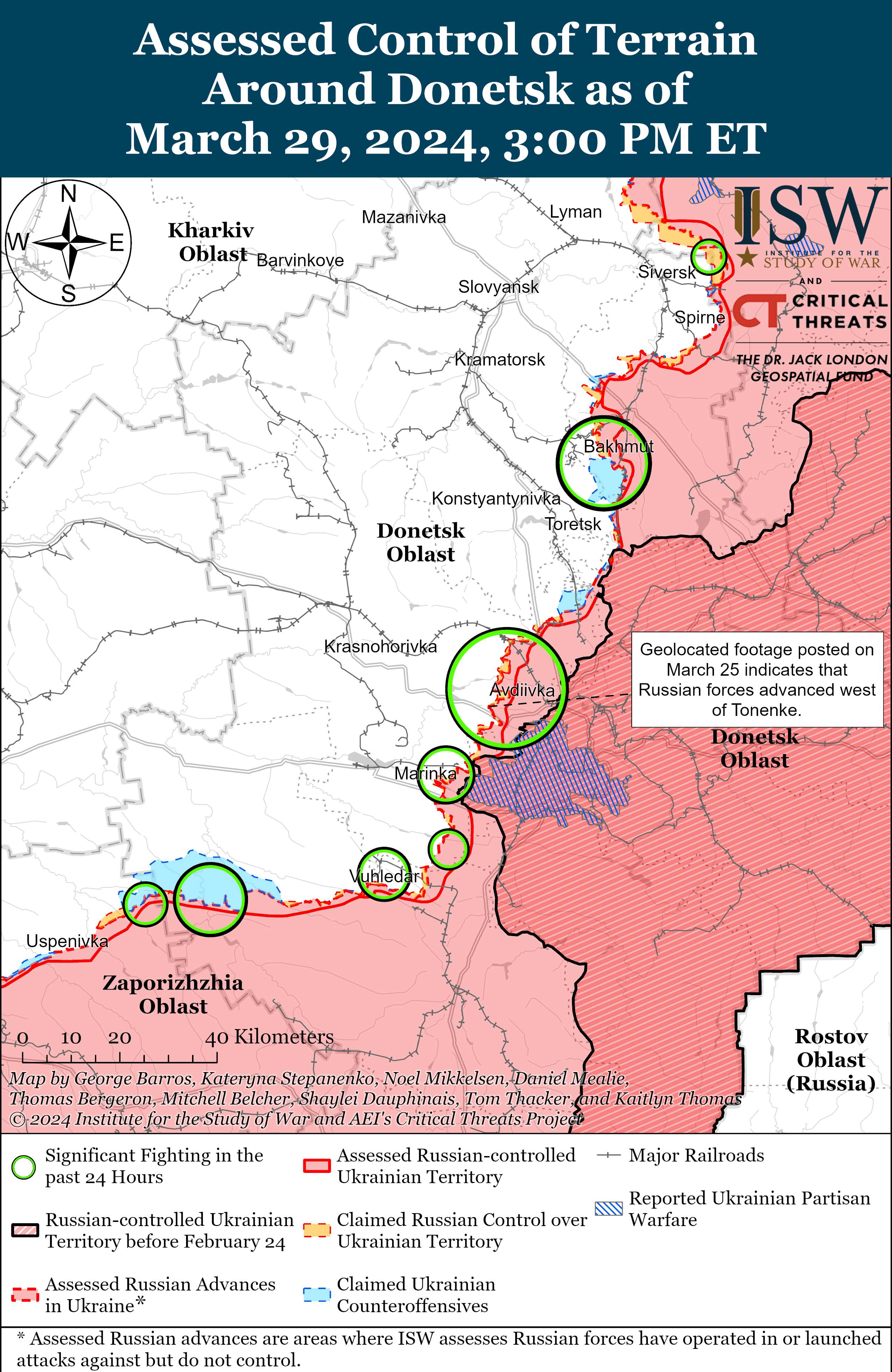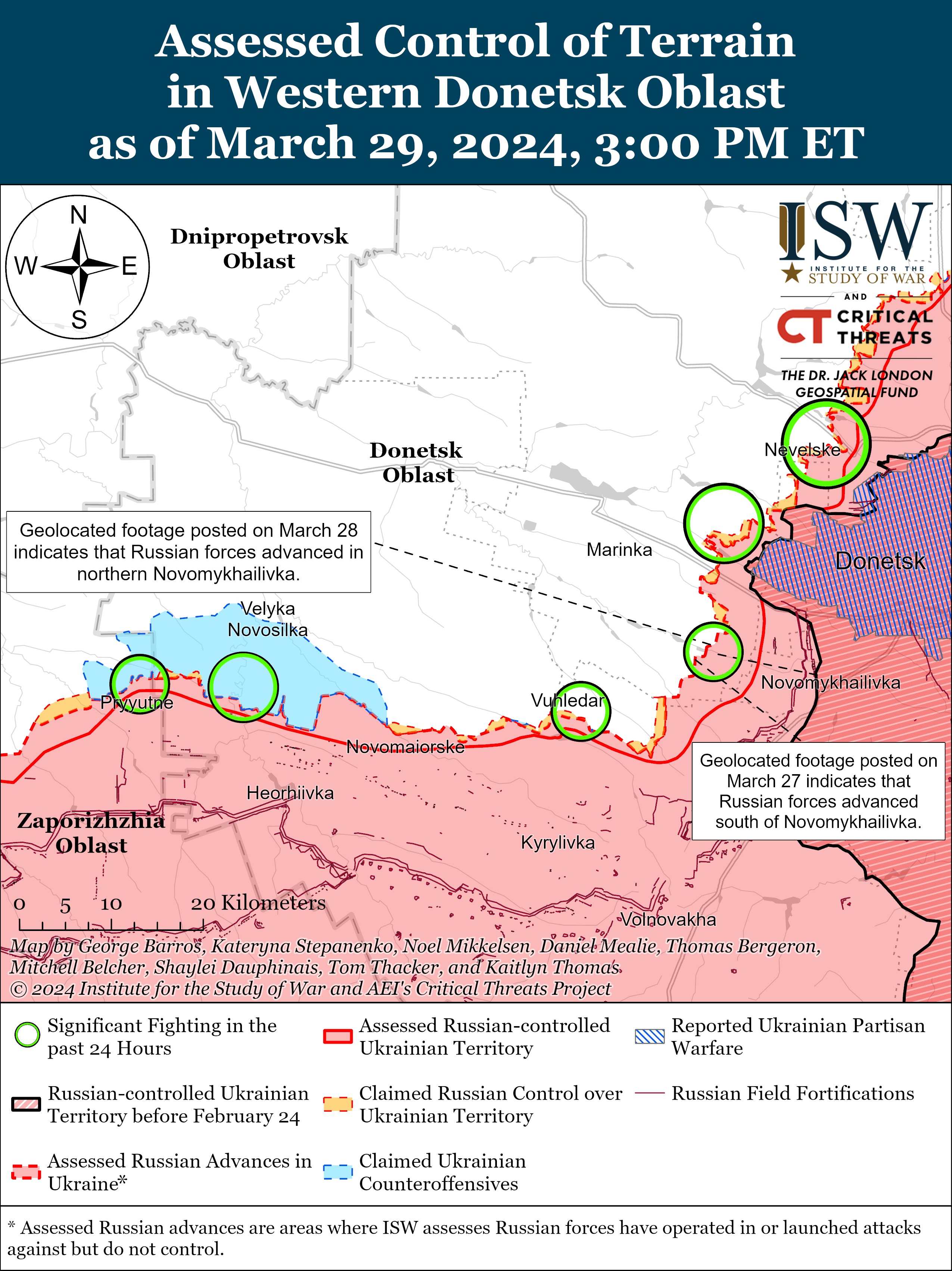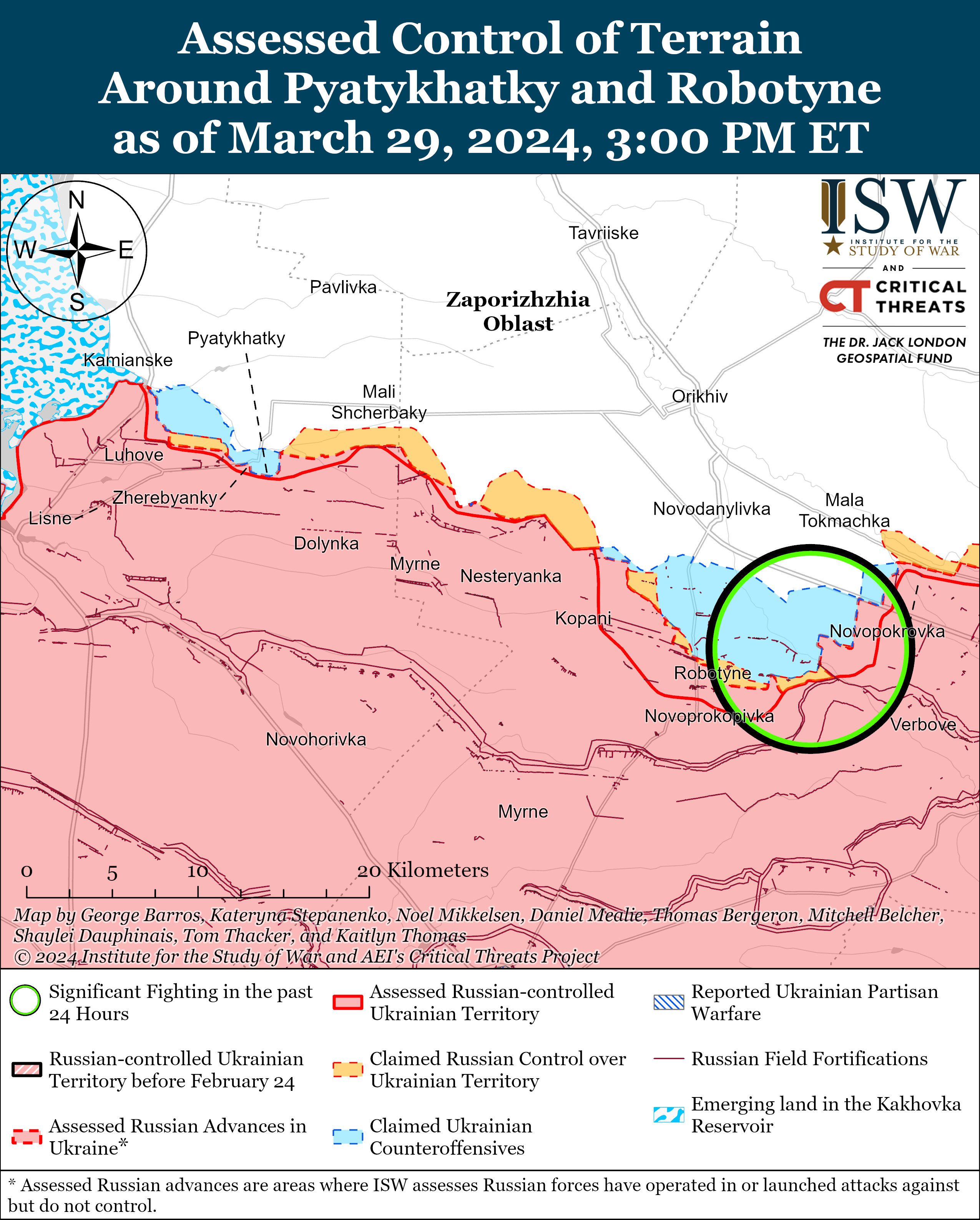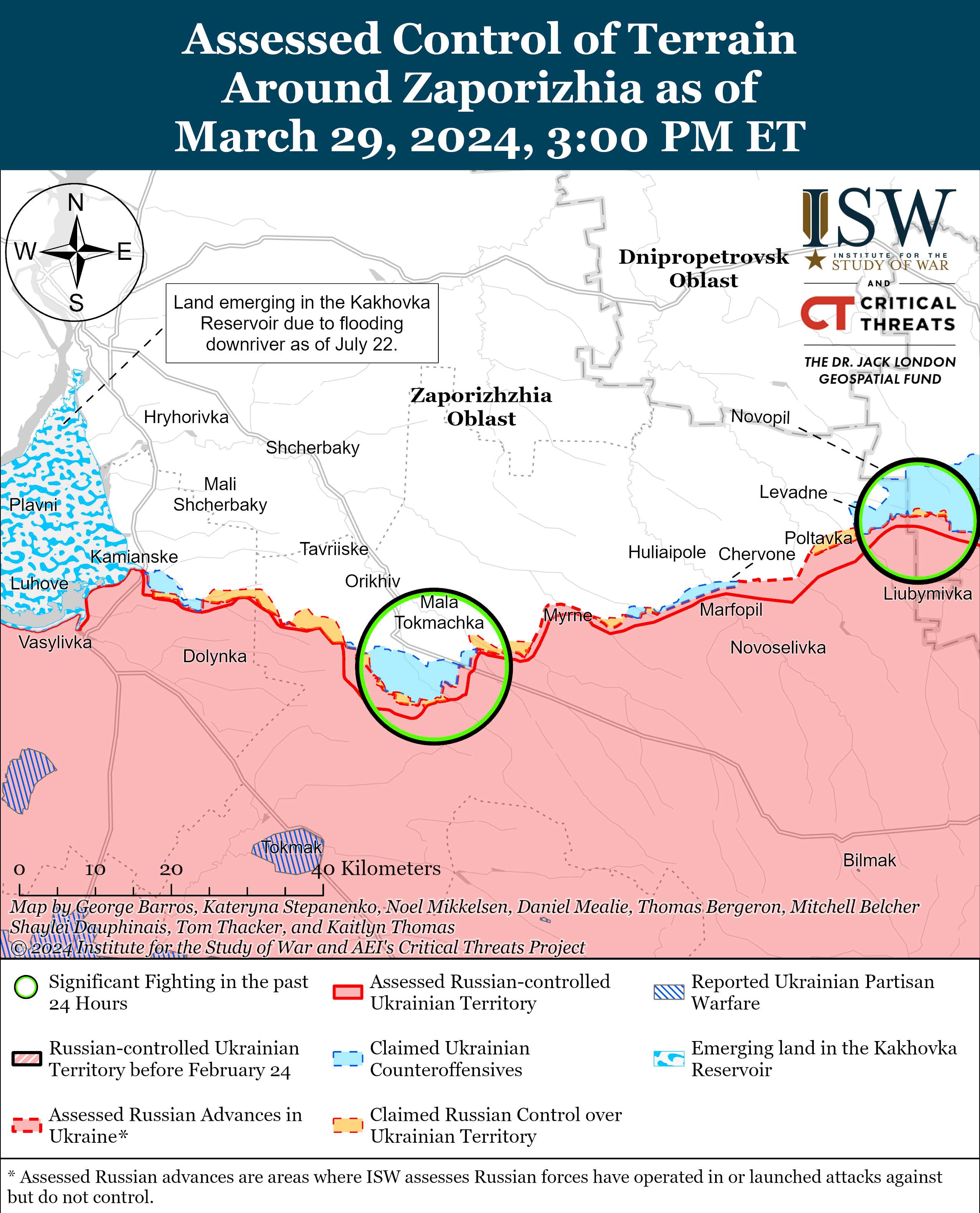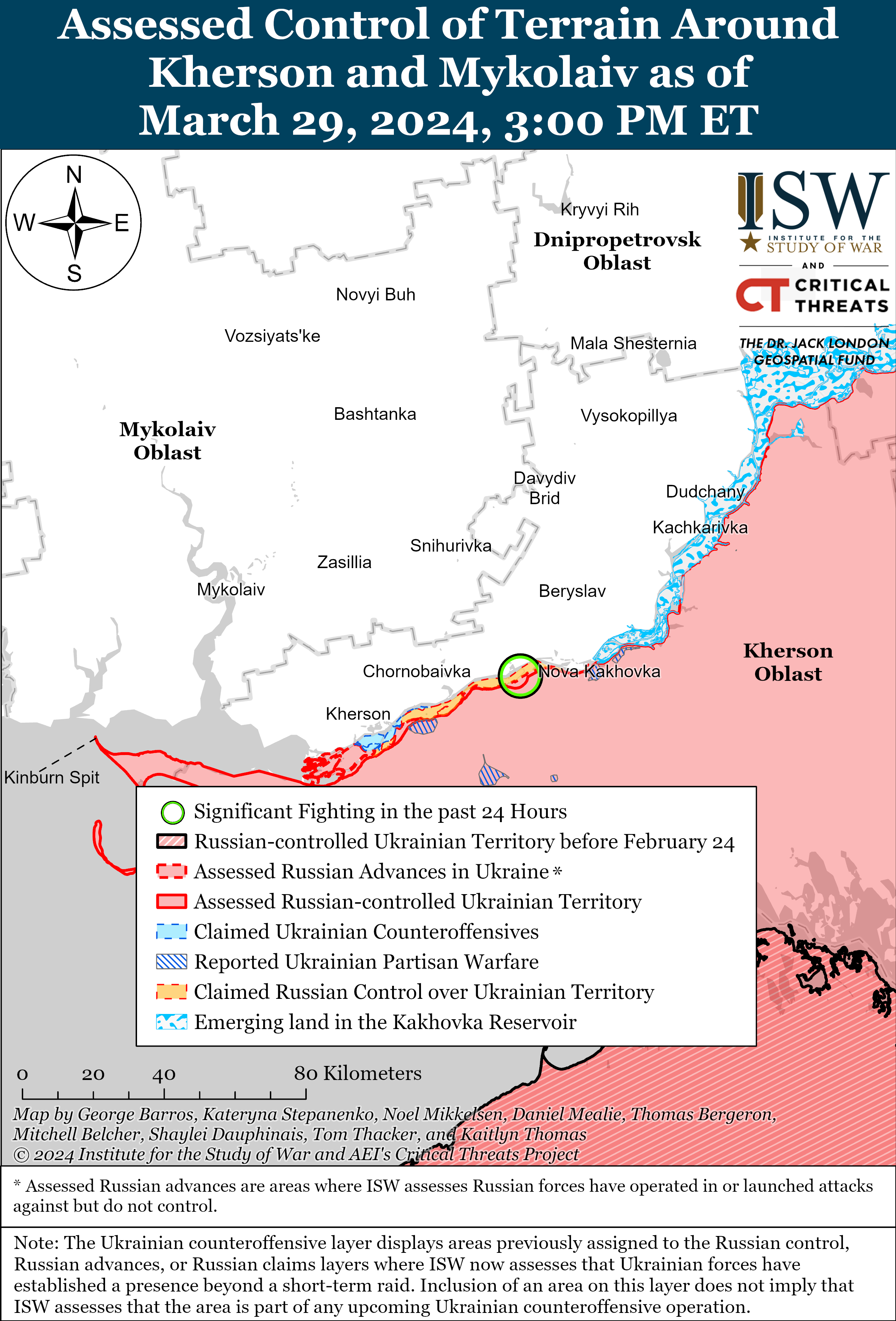Riley Bailey, Christina Harward, Angelica Evans, Grace Mappes, and George Barros
March 29, 2024, 9:30pm ET
Click here to see ISW’s interactive map of the Russian invasion of Ukraine. This map is updated daily alongside the static maps present in this report.
Click here to see ISW’s 3D control of terrain topographic map of Ukraine. Use of a computer (not a mobile device) is strongly recommended for using this data-heavy tool.
Click here to access ISW’s archive of interactive time-lapse maps of the Russian invasion of Ukraine. These maps complement the static control-of-terrain map that ISW produces daily by showing a dynamic frontline. ISW will update this time-lapse map archive monthly.
Note: The data cut-off for this product was 1:15pm ET on March 29. ISW will cover subsequent reports in the March 30 Russian Offensive Campaign Assessment.
The Russian Orthodox Church Moscow Patriarchate (ROC MP), a Kremlin-controlled organization and a known tool within the Russian hybrid warfare toolkit, held the World Russian People’s Council in Moscow on March 27 and 28 and approved an ideological and policy document tying several Kremlin ideological narratives together in an apparent effort to form a wider nationalist ideology around the war in Ukraine and Russia’s expansionist future.[1] ROC MP Head Patriarch Kirill, reportedly himself a former Soviet Committee for State Security (KGB) officer and a known staunch supporter of Russian President Vladimir Putin, chaired the congress of the World Russian People’s Council that approved the document, and Kirill likely coordinated the document’s ideological narrative and policy recommendations with the Kremlin.[2] The document, “The Present and Future of the Russian World,” addresses Russian legislative and executive authorities with specific calls to amend Russian policy documents and laws. These calls are likely either attempts to socialize desired Kremlin policies among Russians before their implementation or to test public reactions to policies that Kremlin officials are currently considering. Putin and Kremlin officials have gradually attempted to elaborate on amorphous ideological narratives about the war in Ukraine and their envisioned geopolitical confrontation with the West since the start of the full-scale invasion, and the ROC MP appears to be offering a more coherent ideological framework for Russians.[3] The ROC MP released the document a week after the Crocus City Hall terrorist attack and roughly a month before the start of the Orthodox Easter Holy Week, and likely aims to seize on heightened anxieties following the terrorist attack and increased Russian Orthodoxy observance to garner support for its desired ultranationalist policies and ideological vision.
The ROC MP intensified Kremlin rhetoric about Russia’s war in Ukraine and cast it as an existential and civilizational “holy war,” a significant inflection for Russian authorities who have so far carefully avoided officially framing Russia’s invasion of Ukraine as any kind of “war.” The ROC MP called Putin’s “special military operation” a holy war (Svyashennaya Voyna) and a new stage in the Russian people’s struggle for “national liberation…in southwestern Russia,” referencing eastern and southeastern Ukraine.[4] The ROC MP claimed that the Russian people are defending their lives, freedom, and statehood; their civilizational, religious, national, and cultural identity; and their right to live within the borders of a single Russian state by waging Putin’s war of conquest in Ukraine. The ROC MP argued that the war in Ukraine is a holy war because Russia is defending “Holy Russia” and the world from the onslaught of globalism and the victory of the West, which has fallen into Satanism. The ROC MP asserted that the war in Ukraine will conclude with Russia seizing exclusive influence over the entire territory of modern Ukraine and the exclusion of any Ukrainian government that the Kremlin determines to be hostile to Russia. The ROC MP’s description of Russian goals is in line with repeated Kremlin statements indicating that Putin retains his objective to destroy Ukrainian sovereignty and statehood.[5] The ROC MP’s use and description of the holy war in Ukraine is also consistent with Kremlin efforts to frame the war as an existential national struggle against Ukraine and the collective West but notably expands the alleged threats that defeat in Ukraine poses for Russians.[6] The term “holy war” may also conjure allusions to the Great Patriotic War (the Second World War), as the Soviet Union’s unofficial war anthem shared the same name, and the Kremlin has routinely invoked the mythos of the Great Patriotic War to generate domestic support for the war in Ukraine.[7] The Kremlin has continued to stress that the war in Ukraine is a “special military operation,” however, and the ROC MP’s direct acknowledgment of the conflict as a holy war may elicit support from Russians who have found the Kremlin’s comparatively restrained rhetoric uninspiring. The ROC MP did not define the holy war as a purely Orthodox concept and instead tied it to the Kremlin’s purposefully broad conception of who is a part of the Russian nation and Russkiy Mir (Russian World).[8] Ukrainian victory does not pose these existential threats, however, as Ukraine’s struggle to restore its territorial integrity, return its people, and defend its national identity does not infringe on Russian identity, statehood, or territorial integrity.
The ROC MP called for the codification of elements of the Russkiy Mir and may be gauging public support for the formal inclusion of ethnic Ukrainians and Belarusians in the Kremlin’s concept of the Russian nation. The ROC MP stated that Russia is the “creator, support, and defender” of the Russkiy Mir and that the Russkiy Mir is a “spiritual, cultural, and civilizational phenomenon” that transcends the borders of the Russian Federation and historical Russian lands and encompasses everyone that values Russian traditions and culture.[9] The ROC MP claimed the Russkiy Mir’s mission is to destroy and prevent efforts to establish “universal hegemony in the world” and that the reunification of the “Russian nation” should be one of the priorities of Russian foreign policy. The ROC MP stated that Russia should return to the “trinity doctrine” of the Russian nation, which falsely asserts that the “Russian nation” is comprised of sub-groups of ethnic Russians, Belarusians, and Ukrainians whom Russia should reunify. The ROC MP called on Russia to codify the “trinity doctrine” in law, make it an “integral part” of the Russian legal system, include it in the “normative list” of Russian spiritual and moral values, and give the concept legal protection. Putin and other Kremlin officials have consistently invoked similar claims about the “Russian people” and Russkiy Mir since before the full-scale Russian invasion of Ukraine as a means to justify Russian aggression against Ukraine while undermining Ukraine’s sovereignty and territorial integrity and denying the existence of a Ukrainian ethnic identity.[10] The ROC MP may be gauging the response to the idea of codifying the “trinity doctrine” on the Kremlin’s orders. The Kremlin may codify this doctrine as official Russian policy.
The ROC MP heavily emphasized Russia’s need for traditional family values and an updated migration policy to counter Russia’s ongoing demographic crisis. The ROC MP labeled Russia’s demographic crisis as Russia’s main existential threat and characterized steady demographic growth as a critical national security priority. The ROC MP asserted that Russia should aim to grow its population to 600 million people (a roughly 450 million increase) in the next 100 years and laid out a series of measures that it envisions would allow Russia to achieve this monumental task. The ROC MP called for the revival of the “traditional large family” and traditional family values in Russia – echoing Russian President Vladimir Putin’s emphasis on 2024 as the “Year of the Family” in recent major national addresses.[11] The ROC MP claimed that the Russian government should recognize the family and its well-being as Russia’s ”main national development goal” and a “strategic national priority” and should amend Russia’s main strategic planning documents to reflect this.[12] The ROC MP called on Russian popular culture to create a “cult of the family” in society and suggested various economic benefits the state should enact to encourage larger families. The ROC MP claimed that a new state migration policy is also key to an “effective” demographic policy. The ROC MP complained that migrants who do not speak Russian, do not understand Russian history and culture, and cannot integrate into Russian society are “deforming” Russia’s unified legal, cultural, and linguistic space. The ROC MP alleged that the “uncontrolled” influx of migrant labor decreases the “indigenous” population’s wages and access to jobs and that “closed ethnic enclaves” are “breeding grounds” for corruption, organized crime, extremism, and terrorism. The ROC MP offered a series of policy recommendations that Russia should prioritize in a new migration policy, including “significant” restrictions on low-skilled foreign laborers, guarantees of employment and high incomes for Russian citizens, protections of the rights and interests of ethnic Russians, and other indigenous peoples of Russia, the mass repatriation of “compatriots” to Russia, and the relocation of highly-skilled foreign specialists who are loyal to Russia and ready to integrate into Russian society.
The ROC MP’s demographic and migration policy suggestions continue to highlight how the Kremlin struggles with inconsistent and contradictory policies concerning migrants and the interests of its ultranationalist population. Select Russian officials and ultranationalist voices have recently called for Russia to enact anti-migrant policies following the Crocus City Hall terrorist attack, but ISW continues to assess that Russia is unlikely to introduce any restrictions that would reduce the number of migrants in Russia given that Russia continues to heavily rely on migrants to offset domestic labor shortages and for force generation efforts.[13] Putin asserted in December 2023 that Russia’s “compatriots abroad” are those who have historical, cultural, or linguistic ties to Russia, and the ROC MP appears to suggest that the repatriation of such “compatriots” to Russia could be a large resource Russia could tap into to solve its demographic crisis.[14] Some of the ROC MP’s other policy recommendations, however, contradictorily seek to restrict some of the very migrants that would fall under Putin’s definition of “compatriots abroad.” The ROC MP’s approach to the Russkiy Mir appears to be at odds with Putin’s previous definition of Russkiy Mir which posits a diverse and inclusive Russian civic nationalism.[15]
The ROC MP appears to be combining previously parallel Kremlin narrative efforts into a relatively cohesive ideology focusing on national identity and demographic resurgence that promises Russians a period of national rejuvenation in exchange for social and civic duties. The ROC MP highlighted that “the restoration of the unity of the Russian people” through the war in Ukraine is a key condition for Russia’s survival and successful development throughout the 21st century. This call for restoration amounts to the full-scale destruction of the Ukrainian nation and its envelopment into Russia. The ROC MP aims to also envelop ethnic Belarusians into the Russian nation through its conception of the “trinity doctrine” while also massively repatriating other “compatriots” abroad. The ROC MP’s calls for Russians to assume the responsibility for steadily increasing birth rates and averting demographic catastrophe similarly promises Russians that Russian sovereignty and identity will persist in the 21st century. These efforts to expand Russia’s control over those it considers to be a part of the Russkiy Mir, whether through mass repatriation or forceful means like Russia’s war of conquest in Ukraine, serve the same purpose as the calls for Russians to increase birth rates — increasing Russia’s overall population with people that ultranationalists consider to be “Russian.” The ROC MP argued that the establishment of a stable and sovereign Russkiy Mir under the Russian state will lead to economic opportunity and Russia’s role as one of the leading centers of a multipolar world order. The ROC MP stated that the typical embodiment of the Russkiy Mir after the promised national rejuvenation would be a Russian family with three or more children and their own single-family home, offering ordinary Russians future socioeconomic benefits in exchange for sacrifices made now in backing the ROC MP’s suggested ultranationalist ideology and achieving Russia’s “unification” with Ukraine and Belarus. The ROC MP’s suggested ideology explicitly ties Russian national security to the preservation of an imagined and disputed Russian nation and Russian demographic growth, offering the Kremlin expanded justifications for acts of aggression against neighboring countries and the West in the name of protecting the overall size and growth of the imagined Russkiy Mir. The Kremlin may choose not to fully align itself publicly with the ultranationalist ideology that the ROC MP has proposed at this time but will highly likely borrow from and leverage it to generate support for the war effort in Ukraine and any future acts of aggression against Russia’s neighbors and the West.
Ukrainian Commander-in-Chief Colonel General Oleksandr Syrskyi stressed that materiel shortages from delays in Western security assistance are constraining Ukrainian forces and forcing Ukraine to conduct a strategic defense. Ukrainian outlet Ukrinform published an interview with Syrskyi on March 29, wherein Syrskyi stated that a strategic defense is logical given Ukraine’s materiel shortages and noted that Ukraine is unable to plan operations due to uncertainty around Western military aid provisions.[16] Syrskyi stated that Russian forces’ significant personnel advantage, heavy Russian airstrikes, and Ukrainian artillery shell shortages enabled Russian forces to break through Ukrainian defenses and seize Avdiivka, Donetsk Oblast, in mid-February 2024, and that Ukrainian forces could have successfully defended Avdiivka if they had sufficient artillery ammunition and air defenses in the area. Syrskyi acknowledged that Russian forces significantly increased airstrikes against Ukrainian forces in recent weeks and months and that Russian forces recently had an advantage over Ukrainian artillery ammunition at a ratio of six to one. Syrskyi stated that Ukrainian forces have been able to offset Russian forces’ artillery superiority through rear area strikes, but only in certain areas of the theater.
Ukrainian forces have proven themselves capable of significantly degrading Russian forces when well-provisioned. Ukrainian forces conducted an interdiction campaign using HIMARS to target bridges over the Dnipro River forcing Russian forces to withdraw from west (right) bank Kherson Oblast in November 2022.[17] Ukrainian forces exploited a surprise breakthrough of Russian lines in Kharkiv Oblast in September 2022.[18] Ukrainian forces are currently waging an ongoing campaign that is limiting the Russian Black Sea Fleet (BSF)’s ability to operate freely in and control the Black Sea.[19] Syrskyi’s interview, particularly his assertion that Ukrainian forces can defend their territory and defeat Russia’s invasion provided sufficient Western military assistance no matter how many soldiers Russia generates, underscores how the American failure to provide timely and consistent military equipment and weapons to Ukraine has constrained Ukraine’s ability to conduct strategic planning or wage major operations.[20] Syrskyi’s statements indicate that Ukraine is attempting to adapt to reduced assistance both on the battlefield and by mobilizing its defense industrial base (DIB), but these efforts are insufficient to fully compensate for the lack of materiel in the near term.[21]
Syrskyi also indicated that Ukraine is attempting to mitigate manpower shortages by reinforcing frontline units with existing personnel from rear areas. Syrskyi stated that Ukrainian forces have transferred thousands of personnel from rear area non-combat units to frontline combat units and begun force rotations to allow frontline forces to rest.[22] Syrskyi stated that Ukrainian forces expect to have sufficient personnel to conduct its strategic defense and that this number is well below the 500,000 personnel that Ukrainian officials had suggested mobilizing in December 2023.[23]
The Russian military likely expanded the target set for Russia’s strike campaign against Ukraine’s critical infrastructure to include hydroelectric power plants. The Ukrainian Air Force reported that Russian forces launched a series of missile and drone strikes at targets in Ukraine on the night of March 28 to 29, including 60 Shahed-136/131 drones from Primorsko-Akhtarsk, Krasnodar Krai and Kursk Oblast; three Kinzhal missiles from MiG-31 aircraft over Ryazan Oblast; nine Kh-59 cruise missiles from Su-34 aircraft over Belgorod Oblast; four Iskander-K missiles from Kursk Oblast; and 21 Kh-101/Kh-555 cruise missiles from Tu-95MS strategic bombers that took off from Engels airbase in Saratov Oblast.[24] Ukrainian air defenses downed 58 Shahed drones, five Kh-59 cruise missiles, all four Iskander-K missiles, and 17 Kh-101/Kh-555 cruise missiles. Ukrainian President Volodymyr Zelensky stated that Russian forces deliberately targeted the Kaniv and Dnister hydroelectric power plants in Cherkasy and Chernivtsi oblasts during the March 28-29 strikes.[25] Ukrainian officials reported that these Russian strikes targeted unspecified critical infrastructure in Ivano-Frankivsk and Dnipropetrovsk oblasts, and Russian milbloggers claimed that Russian forces struck the Kryvyi Rih Thermal Power Plant and the Serednodniprovska Hydroelectric Power Plant in Dnipropetrovsk Oblast.[26] Ukrainian state electricity transmission operator Ukrenergo reported that Russian strikes on March 28-29 damaged thermal and hydroelectric power plants in central and western Ukraine, causing electricity shutdowns in Dnipropetrovsk and Kharkiv oblasts.[27] Russian strikes on March 22 significantly damaged Ukraine’s Dnipro Hydroelectric Power Plant (DHPP) in Zaporizhzhia City and the facility will likely remain offline for some time.[28] ISW previously assessed that Russian strikes against Ukrainian energy facilities may aim to degrade Ukraine’s defense industrial capacity and that Russian forces are likely trying to exploit Ukrainian air defense missile shortages in a renewed attempt to collapse Ukraine’s energy grid.[29]
Russia’s newly emerging pattern of striking Ukrainian dams and hydroelectric power plans is a significant inflection and an escalation of Russia’s strike campaign against Ukraine. Russian forces did not previously conduct sustained missile strikes against Ukrainian dams and hydroelectric power plans. The US and European countries remain unwilling to provide Ukraine with materiel that could prove operationally or strategically significant and assist significant Ukrainian offensive efforts due to fears of Russian escalation or retaliation. Western states’ decisions to limit Ukraine’s defense capabilities in an effort to manage escalation have failed to prevent Russia from escalating its war against Ukraine, however. Ukraine, moreover, is conducting a strategic defense, not an offensive effort that could seriously threaten Russian positions in occupied Ukraine or Russian territory. US Chairman of the Joint Chiefs of Staff General Charles Brown Jr. stated on March 28, regarding the provision of long-range ATACMS missiles to Ukraine, that the “risk of escalation is not as high as maybe it was at the beginning [of Russia’s full-scale invasion of Ukraine].”[30] Russia has consistently proven its willingness to escalate its aggression without provocation, and concern about Russian retaliation and escalation in response to the further provision of Western weapons and systems to Ukraine should not dictate US or other Western decision-making regarding this assistance.[31]
Russia vetoed an annual United Nations Security Council (UNSC) resolution extending a monitoring panel tracking adherence to UN sanctions against North Korea on March 28.[32] China also abstained from the vote. The UN Security Council has unanimously adopted the annual renewal of the North Korean sanctions monitoring panel’s mandate since its inception in 2009.[33] Kremlin Spokesperson Dmitri Peskov vaguely commented that the veto was in Russia’s interest.[34] Russian Ministry of Foreign Affairs (MFA) Spokesperson Maria Zakharova claimed that the UN sanctions against North Korea are “old models” and have led to “severe humanitarian consequences” in North Korea.[35] Zakharova claimed that the “collective West” is responsible for Russia’s veto of the resolution and that the West did not want to accept Russia’s proposed “compromises.”[36] Voice of America (VOA) reported that Russia and China recently attempted to push the UNSC to add “sunset” clauses to some of the sanctions on North Korea in which the sanctions would expire after an unspecified period of time if the UNSC did not reach a consensus on their extension.[37] Russia recently strengthened its relationship with North Korea as part of efforts to source North Korean ballistic missiles and artillery ammunition to use in Ukraine, and Russia may be helping North Korea evade international sanctions beyond the immediate violations of sanctions involved in North Korean weapons transfers to Russia.[38] Russia’s veto of the supervisory panel is likely part of Russian efforts to prevent the detection of Russia’s own sanctions evasion schemes with North Korea. Russia may also have suspected that the UNSC would not approve the “sunset” clause proposals and instead used these proposals to set information conditions to later blame the West for the expiration of the monitoring panel’s mandate. Kremlin newswire TASS stated on March 27 that Russian Foreign Intelligence Service (SVR) Director Sergei Naryshkin met with North Korean Minister of State Security Ri Chang-dae in Pyongyang during a visit on March 25-27 and discussed deepening Russian-North Korean relations.[39]
The Kremlin appears to have succeeded in pressuring Telegram to further censor extremist content following the March 22 Crocus City Hall attack, highlighting the Kremlin’s ability to pressure significant actors within the Russian information space to act in its interests. Telegram founder and CEO Pavel Durov stated on March 28 that Telegram began measures to prevent extremist posts calling for terrorist attacks on March 24, preventing tens of thousands of alleged attempts to send messages calling for terrorist attacks and blocking thousands of users who sent such messages.[40] Durov stated that Telegram users in Russia, Ukraine, and Belarus will be able to limit who can send them private messages beginning next week and emphasized that Telegram is not a place to call for violence.[41] Kremlin Spokesperson Dmitri Peskov stated on March 28 that Russia has no plans to block Telegram but specifically called on Durov by name to pay more attention to how terrorists use the platform and that the Kremlin “expected more” from Durov.[42] The Kremlin’s ability to pressure Durov is noteworthy given that Telegram is no longer based in Russia, and Durov reportedly left Russia in 2014 after refusing to cooperate with Russian censorship measures.[43]
Key Takeaways:
- The Russian Orthodox Church Moscow Patriarchate (ROC MP), a Kremlin-controlled organization and a known tool within the Russian hybrid warfare toolkit, held the World Russian People’s Council in Moscow on March 27 and 28 and approved an ideological and policy document tying several Kremlin ideological narratives together in an apparent effort to form a wider nationalist ideology around the war in Ukraine and Russia’s expansionist future.
- The ROC MP intensified Kremlin rhetoric about Russia’s war in Ukraine and cast it as an existential and civilizational “holy war,” a significant inflection for Russian authorities who have so far carefully avoided officially framing Russia’s invasion of Ukraine as any kind of “war.”
- The ROC MP called for the codification of elements of the Russkiy Mir and may be gauging public support for the formal inclusion of ethnic Ukrainians and Belarusians in the Kremlin’s concept of the Russian nation.
- The ROC MP heavily emphasized Russia’s need for traditional family values and an updated migration policy to counter Russia’s ongoing demographic crisis.
- The ROC MP appears to be combining previously parallel Kremlin narrative efforts into a relatively cohesive ideology focusing on national identity and demographic resurgence that promises Russians a period of national rejuvenation in exchange for social and civic duties.
- Ukrainian Commander-in-Chief Colonel General Oleksandr Syrskyi stressed that materiel shortages from delays in Western security assistance are constraining Ukrainian forces and forcing Ukraine to conduct a strategic defense.
- The Russian military likely expanded the target set for Russia’s strike campaign against Ukraine’s critical infrastructure to include hydroelectric power plants.
- Russia vetoed an annual United Nations Security Council (UNSC) resolution extending a monitoring panel tracking adherence to UN sanctions against North Korea on March 28.
- The Kremlin appears to have succeeded in pressuring Telegram to further censor extremist content following the March 22 Crocus City Hall attack, highlighting the Kremlin’s ability to pressure significant actors within the Russian information space to act in its interests.
- Russian forces recently made confirmed advances near Bakhmut, Avdiivka, and Donetsk City and in the Donetsk-Zaporizhia Oblast border area amid continued positional engagements along the entire line of contact on March 29.
- The Russian Ministry of Defense (MoD) is preparing for Russia’s semi-annual spring conscription cycle, which will begin on April 1.
- Russian occupation authorities continue law enforcement crackdowns, including against the Crimean Tatar ethnic minority, to consolidate control over occupied Ukraine.
We do not report in detail on Russian war crimes because these activities are well-covered in Western media and do not directly affect the military operations we are assessing and forecasting. We will continue to evaluate and report on the effects of these criminal activities on the Ukrainian military and the Ukrainian population and specifically on combat in Ukrainian urban areas. We utterly condemn Russian violations of the laws of armed conflict and the Geneva Conventions and crimes against humanity even though we do not describe them in these reports.
- Russian Main Effort – Eastern Ukraine (comprised of two subordinate main efforts)
- Russian Subordinate Main Effort #1 – Capture the remainder of Luhansk Oblast and push westward into eastern Kharkiv Oblast and encircle northern Donetsk Oblast
- Russian Subordinate Main Effort #2 – Capture the entirety of Donetsk Oblast
- Russian Supporting Effort – Southern Axis
- Russian Air, Missile, and Drone Campaign
- Russian Mobilization and Force Generation Efforts
- Russian Technological Adaptations
- Activities in Russian-occupied areas
- Ukrainian Defense Industrial Base Efforts
- Russian Information Operations and Narratives
- Significant Activity in Belarus
Russian Main Effort – Eastern Ukraine
Russian Subordinate Main Effort #1 – Luhansk Oblast (Russian objective: Capture the remainder of Luhansk Oblast and push westward into eastern Kharkiv Oblast and northern Donetsk Oblast)
Positional engagements continued along the Kupyansk-Svatove-Kremmina line on March 29, but there were no confirmed changes to the frontline in this area. Ukrainian and Russian sources stated that positional engagements continued west of Kreminna near Terny and south of Kreminna near Bilohorivka.[44] The deputy commander of a Ukrainian detachment operating in the Kupyansk and Lyman directions stated that Russian forces continue to concentrate roughly 100,000 personnel in the Kupyansk and Lyman directions and must conduct rotations (likely tactical-level rotations) at least once a week due to manpower and equipment losses.[45] The deputy commander stated that Russian forces are accumulating personnel and equipment and transferring unspecified additional forces to the Kupyansk direction to continue efforts to seize Kupyansk and Kupyansk-Vuzlovy. The deputy commander stated that Russian forces are most active in the Lyman direction near Bilohorivka and Terny and are unsuccessfully trying to advance in the Kupyansk direction near Synkivka (northeast of Kupyansk) and Ivanivka (southeast of Kupyansk). The deputy commander stated that Ukrainian forces have not observed any Russian sabotage and reconnaissance groups attempting to enter Ukraine across Ukraine’s international border with Russia, and Ukrainian Kharkiv Oblast Head Oleh Synehubov stated that Ukrainian forces have not observed Russian forces concentrating for attacks on Kharkiv City.[46] Elements of the Russian 7th Motorized Rifle Brigade (2nd Luhansk People’s Republic [LNR] Army Corps [AC]) are reportedly operating near Bilohorivka.[47]
Russian Subordinate Main Effort #2 – Donetsk Oblast (Russian objective: Capture the entirety of Donetsk Oblast, the claimed territory of Russia’s proxies in Donbas)
Russian forces recently marginally advanced west of Bakhmut amid continued positional engagements in the area on March 29. Geolocated footage published on March 26 indicates that Russian forces recently advanced within Ivanivske (west of Bakhmut).[48] A Russian milblogger claimed that Russian forces advanced in Bohdanivka (northwest of Bakhmut), although ISW has not observed visual confirmation of this claim.[49] Positional engagements continued west of Bakhmut near Chasiv Yar, the Novyi district (eastern part of Chasiv Yar), and Ivanivske and southwest of Bakhmut near Klishchiivka and Andriivka.[50] The spokesperson for a Ukrainian brigade operating in the Bakhmut direction stated that Russian first-person-view (FPV) drones and reconnaissance drones pose a significant threat to Ukrainian forces in the area and that Russian forces are using them in greater numbers.[51] Elements of the Russian 11th Separate Guards Air Assault (VDV) Brigade are reportedly operating west of Ivanivske.[52]
Russian forces recently made confirmed advances northwest and west of Avdiivka amid continued positional engagements in the area on March 29. Geolocated footage published on March 28 indicates that Russian forces recently marginally advanced north of Krasnohorivka (northwest of Avdiivka).[53] Additional geolocated footage published on March 19 indicates that Russian forces marginally advanced south of Nevelske (southwest of Avdiivka).[54] Russian milbloggers claimed that Russian forces are gradually advancing northwest and west of Tonenke (west of Avdiivka).[55] Positional engagements continued northwest of Avdiivka near Semenivka and Berdychi; west of Avdiivka near Tonenke and Umanske; and southwest of Avdiivka near Pervomaiske and Nevelske.[56]
Russian forces recently marginally advanced southwest of Donetsk City amid continued positional fighting in the area on March 29. Geolocated footage published on March 28 and 29 indicates that Russian forces recently marginally advanced north of Novomykhailivka (southwest of Donetsk City).[57] Russian milbloggers claimed that elements of the Russian 155th Naval Infantry Brigade (Pacific Fleet) recently advanced in central Novomykhailivka.[58] A Kremlin-affiliated Russian milblogger claimed that Russian forces are advancing west along Tsentralna and Haharina streets in Heorhiivka (west of Donetsk City).[59] Other Russian and Ukrainian sources claimed that positional engagements continued west of Donetsk City near Krasnohorivka and Heorhiivka and southwest of Donetsk City near Vodyane.[60]
Russian forces recently marginally advanced in the Donetsk-Zaporizhia Oblast border area amid continued positional fighting in the area on March 29. Geolocated footage published on March 29 indicates that Russian forces recently marginally advanced south of Urozhaine (south of Velyka Novosilka).[61] Positional engagements continued near Staromayorske (south of Velyka Novosilka) and north of Pryyutne (southwest of Velyka Novosilka).[62] Elements of the Russian 30th Artillery Brigade (36th Combined Arms Army [CAA], Eastern Military District [EMD]) are reportedly operating in the Shakhtarske direction (Donetsk-Zaporizhia Oblast border area).[63]
Russian Supporting Effort – Southern Axis (Russian objective: Maintain frontline positions and secure rear areas against Ukrainian strikes)
Positional fighting continued near Robotyne and northwest of Verbove (east of Robotyne) in western Zaporizhia Oblast on March 29, but there were no confirmed changes to the frontline.[64] Elements of the Russian 71st Motorized Rifle Regiment (42nd Motorized Rifle Division, 58th Combined Arms Army [CAA], Southern Military District [SMD]) reportedly continue fighting near Robotyne.[65]
Positional fighting continued in east (left) bank Kherson Oblast on March 29, presumably near Krynky.[66]
Russian Air, Missile, and Drone Campaign (Russian Objective: Target Ukrainian military and civilian infrastructure in the rear and on the frontline)
See topline text.
Russian Mobilization and Force Generation Efforts (Russian objective: Expand combat power without conducting general mobilization)
The Russian Ministry of Defense (MoD) is preparing for Russia’s semi-annual spring conscription cycle, which is scheduled to begin on April 1. Russian Deputy Chief of the General Staff Vice Admiral Vladimir Tsimlyansky stated on March 29 that the 2024 spring conscription cycle will start on April 1 in all Russian federal subjects, including in occupied Ukraine, except for certain federal subjects in northern Russia due to inclement weather.[67] Russian officials have previously reported that the Russian military will conscript 130,000 people during the 2024 spring conscription cycle.[68] Tsimlyansky stated that the Russian military plans to start sending conscripts to assembly points on April 15 and that a third of the conscripts will serve in training units and military units to receive specialized training.[69] Tsimlyansky stated that the Russian military will continue to form specialized units – scientific research companies – to solve unspecified research and development problems.[70] Tsimlyansky stressed that Russia will not send conscripts to occupied Ukraine and that conscripts will not participate in combat or support operations associated with the war in Ukraine.[71] ISW continues to assess that the Kremlin remains unlikely to deploy conscripts to participate in combat operations in Ukraine due to concerns that conscript causalities may cause societal discontent within Russia.[72] Russian forces have relied on conscripts for border security, specifically in Belgorod and Kursk oblasts, and Russian opposition outlet Verstka recently reported that Russian officials may intend to send conscripts to Russia’s southern border in support roles or as border troops as part of efforts to free up more experienced military personnel.[73] Verstka also reported that Russian authorities intend to significantly expand crypto-mobilization efforts during the 2024 spring conscription cycle.[74]
Russian Technological Adaptations (Russian objective: Introduce technological innovations to optimize systems for use in Ukraine)
Nothing significant to report.
Ukrainian Defense Industrial Efforts (Ukrainian objective: Develop its defense industrial base to become more self-sufficient in cooperation with US, European, and international partners)
ISW is not publishing coverage of Ukrainian defense industrial efforts today.
Activities in Russian-occupied areas (Russian objective: Consolidate administrative control of annexed areas; forcibly integrate Ukrainian citizens into Russian sociocultural, economic, military, and governance systems)
Russian occupation authorities continue law enforcement crackdowns, including against the Crimean Tatar ethnic minority, to consolidate control over occupied Ukraine. Russian opposition outlet Astra reported on March 28 that footage reportedly shows Russian Federal Security Service (FSB) officers arresting a Crimean Tatar man whom the FSB accused of being a member of a terrorist organization.[75] Russian occupation authorities have extensively persecuted Crimean Tatar people and activists in an attempt to eradicate Ukrainian and Crimean Tatar national identities to further secure control over occupied Crimea and have leveraged allegations of suspects’ connections to extremist groups as a pretext to imprison them.[76] The Ukrainian Resistance Center reported on March 26 that Russian law enforcement began investigating Tajik and Uzbek nationals living in occupied Ukraine following the Crocus City Hall terrorist attack on March 22.[77] Ukrainian Prosecutor General Andriy Kostin reported on March 26 that Russian authorities are holding over 10,000 Ukrainian civilians as prisoners in occupied Ukraine and Russia.[78]
Ukraine’s Main Military Intelligence Directorate (GUR) reported on March 22 that Ukrainian partisans detonated explosives in occupied Melitopol, Zaporizhia Oblast, killing 20 Russian personnel and destroying two Kamaz trucks and a UAZ Patriot SUV.[79]
Russian authorities continue efforts to restore and expand transport, industrial, and military infrastructure to support Russia’s war in and long-term occupation of Ukraine. Kherson Oblast occupation head Vladimir Saldo claimed on March 28 that Russian authorities repaired 300 kilometers of roadway in occupied Kherson Oblast in 2023.[80] Saldo stated that Kherson Oblast occupation authorities will also support the construction of a railway running through Rostov-on-Don, Berdyansk, Melitopol, and to Crimea through occupied Kherson Oblast as well as rail lines through Skadovsk, Kherson Oblast.[81] Ukrainian Mariupol Mayoral Advisor Petro Andryushchenko reported that Russian authorities are building rail lines through Telmanivskyi Raion, Donetsk Oblast, east of the Volnovakha-Mariupol line on the international border with Russia.[82] Ukrainian Security Service (SBU) Head Oleksandr Pavlyuk recently stated that Russian forces have stopped using the Kerch Strait railway bridge for military and logistics transport.[83] Ukrainian Zaporizhia Oblast Head Ivan Fedorov reported on March 28 that Russian authorities are building dozens of military training camps and bases for Russian forces in occupied Ukraine.[84] Ukrainian Luhansk Oblast Head Artem Lysohor reported on March 25 that Russian occupation authorities are forcing the sale of 11 total coal mines presumably to the occupation administration or pro-Russian collaborators in occupied Luhansk Oblast, likely to support Russia’s effort to revitalize its defense industrial base (DIB) and solidify control over occupied Ukraine.[85]
Russian Information Operations and Narratives
Russian officials continued to criticize Armenia for distancing itself from Russia and are using language Russia has previously used to describe its relationship with Ukraine. The Russian Ministry of Foreign Affairs (MFA) stated that Russia’s 102nd Military Base in Gyumri, Armenia is the “only real guarantee of the sovereignty of Armenia,” echoing Russian President Vladimir Putin’s previous claims that Russia is the sole guarantor of Ukraine’s sovereignty.[86] Russian Ambassador to Armenia Sergei Koprykin claimed that Russian-Armenian relations will suffer from “real damage” if Armenia lacks “sufficient political will” to defend its relationship with Russia.[87]
The Russian Investigative Committee continues to claim that it has evidence connecting Ukraine to the March 22 Crocus City Hall attack as part of the Kremlin’s efforts to garner more domestic support for the war in Ukraine.[88] Kremlin newswire TASS reported that the Investigative Committee’s Department for the Investigation of War Crimes, Genocide, and the Rehabilitation of Nazism is handling the terrorist attack case – a Kremlin effort to use legal mechanisms to legitimize its claims of Ukraine’s involvement.[89] ISW continues to assess with high confidence that the Islamic State (IS) conducted the Crocus City Hall attack and has yet to observe independent reporting or evidence to suggest that an actor other than IS was responsible for or aided the attack.[90]
Significant activity in Belarus (Russian efforts to increase its military presence in Belarus and further integrate Belarus into Russian-favorable frameworks and Wagner Group activity in Belarus)
Nothing significant to report.
Note: ISW does not receive any classified material from any source, uses only publicly available information, and draws extensively on Russian, Ukrainian, and Western reporting and social media as well as commercially available satellite imagery and other geospatial data as the basis for these reports. References to all sources used are provided in the endnotes of each update.

[1] http://www.patriarchia dot ru/db/text/6116189.html
[2] https://www.tdg dot ch/pretre-espion-propagandiste-la-vie-secrete-du-chef-de-leglise-russe-en-suisse-766374038310 ; https://www.rts dot ch/info/suisse/13758343-le-patriarche-orthodoxe-russe-kirill-a-espionne-la-suisse-pour-le-kgb-dans-les-annees-70.html
[3] https://isw.pub/UkrWar021524 ; https://isw.pub/UkrWar013024
[4] http://www.patriarchia dot ru/db/text/6116189.html
[5] https://isw.pub/UkrWar022424
[6] https://isw.pub/UkrWar032624 ; https://isw.pub/UkrWar020724 ; https://isw.pub/UkrWar012724 ;
[7] https://isw.pub/UkrWar020224 ; https://isw.pub/UkrWar012724
[8] https://isw.pub/UkrWar032824 ; https://isw.pub/UkrWar030424 ; https://isw.pub/UkrWar021924
[9] http://www.patriarchia dot ru/db/text/6116189.html
[10] http://en dot kremlin.ru/events/president/news/66181 ; https://isw.pub/UkrWar121923 ; https://isw.pub/UkrWar121323 ; https://isw.pub/UkrWar012224 ; https://isw.pub/UkrWar112823 ; https://isw.pub/UkrWar121723 ; https://isw.pub/UkrWar121923 ; https://isw.pub/UkrWar030424 ; https://isw.pub/UkrWar032824
[11] http://www.patriarchia dot ru/db/text/6116189.html ; https://isw.pub/UkrWar022924; https://isw.pub/UkrWar123123 ; https://isw.pub/UkrWar012324
[12] http://www.patriarchia dot ru/db/text/6116189.html
[13] https://isw.pub/UkrWar032824 ; https://isw.pub/UkrWar032724 ; https://isw.pub/UkrWar032624 ; https://isw.pub/UkrWar032424 ; https://isw.pub/UkrWar032324
[14] https://understandingwar.org/ukraine-conflicts-updates-2023
[15] https://isw.pub/UkrWar112823
[16] https://www.ukrinform dot ua/amp/rubric-ato/3845632-oleksandr-sirskij-golovnovnokomanduvac-zsu.html; https://t.me/osirskiy/640
[17] https://understandingwar.org/backgrounder/russian-offensive-campaign-assessment-november-10-2023; https://understandingwar.org/backgrounder/special-edition-campaign-assessment-ukraine%E2%80%99s-strike-campaign-against-crimea; https://understandingwar.org/wp-content/uploads/2024/03/Russian20Offensive20Campaign20Assessment2C20December20220PDF.pdf; https://understandingwar.org/backgrounder/russian-offensive-campaign-assessment-september-7
[18] https://understandingwar.org/backgrounder/russian-offensive-campaign-assessment-november-10-2023; https://understandingwar.org/backgrounder/special-edition-campaign-assessment-ukraine%E2%80%99s-strike-campaign-against-crimea; https://understandingwar.org/wp-content/uploads/2024/03/Russian20Offensive20Campaign20Assessment2C20December20220PDF.pdf; https://understandingwar.org/backgrounder/russian-offensive-campaign-assessment-september-7
[19] https://understandingwar.org/backgrounder/russian-offensive-campaign-assessment-november-10-2023; https://understandingwar.org/backgrounder/special-edition-campaign-assessment-ukraine%E2%80%99s-strike-campaign-against-crimea; https://understandingwar.org/wp-content/uploads/2024/03/Russian20Offensive20Campaign20Assessment2C20December20220PDF.pdf; https://understandingwar.org/backgrounder/russian-offensive-campaign-assessment-september-7
[20] https://www.ukrinform dot ua/amp/rubric-ato/3845632-oleksandr-sirskij-golovnovnokomanduvac-zsu.html; https://t.me/osirskiy/640
[21] https://www.ukrinform dot ua/amp/rubric-ato/3845632-oleksandr-sirskij-golovnovnokomanduvac-zsu.html; https://t.me/osirskiy/640
[22] https://www.ukrinform dot ua/amp/rubric-ato/3845632-oleksandr-sirskij-golovnovnokomanduvac-zsu.html; https://t.me/osirskiy/640
[23] https://www.pravda dot com.ua/eng/news/2023/12/19/7433742/
[24] https://t.me/kpszsu/12534 ; https://www.facebook.com/GeneralStaff.ua/posts/pfbid0eR1SWb1UMb3GNcF6aCVdqvrXi8skQnBJvU666oGCucoXuDYNN1HshtaTbn9Fj8qsl
[25] https://armyinform dot com.ua/2024/03/29/prezydent-proviv-stavku-obgovoryly-zahyst-energetychnyh-obyektiv-i-kontrakty-na-postachannya-zbroyi/ ; https://t.me/V_Zelenskiy_official/9923
[26] https://suspilne dot media/716264-rosia-atakuvala-obekt-kriticnoi-infrastrukturi-na-frankivsini-povitrani-cili-zneskodili/; https://t.me/onyshchuksvitlana/12549 ; https://t.me/dnipropetrovskaODA/11702 ; https://t.me/dnipropetrovskaODA/11703 ; https://t.me/dnipropetrovskaODA/11704 ; https://t.me/dnipropetrovskaODA/11708; https://t.me/boris_rozhin/118364 ; https://t.me/boris_rozhin/118394 ; https://t.me/dva_majors/38517 ; https://t.me/boris_rozhin/118362 ; https://t.me/DnevnikDesantnika/8784 ; https://t.me/wargonzo/19073
[27] https://armyinform dot com.ua/2024/03/29/vnochi-rosiyany-atakuvaly-teplovi-ta-gidroelektrostancziyi-v-kilkoh-regionah-ukrayiny/
[28] https://isw.pub/UkrWar032224
[29] https://isw.pub/UkrWar032224
[30] https://www.defenseone.com/threats/2024/03/giving-atacms-ukraine-no-longer-risky-says-joint-chiefs-chairman/395329/ ; https://t.me/tass_agency/240576 ; https://suspilne dot media/716894-golovnokomanduvac-armii-ssa-ociniv-mozlivist-rosii-rozpocati-novij-nastup-proti-ukraini/
[31] https://isw.pub/UkrWar031824 ; https://isw.pub/UkrWar113023 ; https://understandingwar.org/backgrounder/denying-russia%E2%80%99s-only-strategy-success
[32] https://www.cnn.com/2024/03/29/asia/russia-veto-un-sanctions-north-korea-intl-hnk/index.html
[33] https://usun.usmission.gov/explanation-of-vote-following-russias-veto-of-a-un-security-council-resolution-to-renew-the-mandate-of-the-1718-committee-panel-of-experts-2/
[34] https://t.me/tass_agency/240666
[35] https://t.me/MID_Russia/38181
[36] https://t.me/MID_Russia/38181
[37] https://www.voanews.com/a/why-russia-killed-un-panel-that-monitors-nkorea-sanctions/7549031.html
[38] https://understandingwar.org/backgrounder/russian-offensive-campaign-assessment-march-28-2024 ; https://isw.pub/UkrWar031124 ; https://isw.pub/UkrWar021024 ; https://isw.pub/UkrWar020624 ; https://isw.pub/UkrWar020624
[39] https://tass dot ru/politika/20379771
[40] https://t.me/tass_agency/240578 ; https://t.me/tass_agency/240579 ; https://t.me/tass_agency/240580; https://t.me/durov_russia/52
[41] https://t.me/durov_russia/52
[42] https://t.me/tass_agency/240467 ; https://t.me/kremlin_sekret/14505
[43] https://www.nytimes.com/2014/12/03/technology/once-celebrated-in-russia-programmer-pavel-durov-chooses-exile.html ; https://www.britannica.com/topic/Telegram-software
[44] https://t.me/mod_russia/37148 ; https://t.me/luhanskaVTSA/17884 ; https://www.facebook.com/GeneralStaff.ua/posts/pfbid0pZyhyaJ346LZhEUhbM8Kt2yCPyvqDtov1cvX4abUPTaQ1Xw9uDiK2qxQXPPd1bhBl ; https://www.facebook.com/GeneralStaff.ua/posts/pfbid02otmeeMogVrjHSKwrTZLW2HSkUHWZb7sc3Zo7JMHnq2eQVutjcFjERLpmUejZ5nrBl ; https://www.facebook.com/GeneralStaff.ua/posts/pfbid0Fy7c6ap9GKXvZa4gwFdzwMuLFPFsR6tehPKFr7jCe4HAP6CJrQ8h4jj3PbJroV8ql
[45] https://suspilne dot media/716224-rosia-postijno-ponovlue-osobovij-sklad-ta-provodit-rotacii-na-limano-kupanskomu-napramku-cerez-vtrati-sevcov/
[46] https://suspilne dot media/716224-rosia-postijno-ponovlue-osobovij-sklad-ta-provodit-rotacii-na-limano-kupanskomu-napramku-cerez-vtrati-sevcov/ ; https://t.me/synegubov/8854
[47] https://t.me/sons_fatherland/13527
[48] https://t.me/opbr_zsu/244; https://t.me/creamy_caprice/4921
[49] https://t.me/wargonzo/19066
[50] https://www.facebook.com/GeneralStaff.ua/posts/pfbid0pZyhyaJ346LZhEUhbM8Kt2yCPyvqDtov1cvX4abUPTaQ1Xw9uDiK2qxQXPPd1bhBl ; https://www.facebook.com/GeneralStaff.ua/posts/pfbid02otmeeMogVrjHSKwrTZLW2HSkUHWZb7sc3Zo7JMHnq2eQVutjcFjERLpmUejZ5nrBl ; https://www.facebook.com/GeneralStaff.ua/posts/pfbid0Fy7c6ap9GKXvZa4gwFdzwMuLFPFsR6tehPKFr7jCe4HAP6CJrQ8h4jj3PbJroV8ql ; https://www.facebook.com/GeneralStaff.ua/posts/pfbid02otmeeMogVrjHSKwrTZLW2HSkUHWZb7sc3Zo7JMHnq2eQVutjcFjERLpmUejZ5nrBl ; https://www.facebook.com/GeneralStaff.ua/posts/pfbid0Fy7c6ap9GKXvZa4gwFdzwMuLFPFsR6tehPKFr7jCe4HAP6CJrQ8h4jj3PbJroV8ql ; https://t.me/dva_majors/38516 ; https://t.me/DnevnikDesantnika/8782 ; https://t.me/negumanitarnaya_pomosch_Z/16222
[51] https://armyinform dot com.ua/2024/03/28/u-sylah-oborony-rozpovily-pro-royi-vorozhyh-droniv-na-bahmutskomu-napryamku-ta-snaryady-z-kndr/
[52] https://t.me/mod_russia/37146
[53] https://twitter.com/giK1893/status/1773470351961317533; https://t.me/officer_alex33/2414; https://twitter.com/giK1893/status/1773470354704392438;
[54] https://twitter.com/thisisnotdirk/status/1773732497102082097; https://t.me/Lugansk_111OBr_TrO/261; https://twitter.com/thisisnotdirk/status/1773732500512084362
[55] https://t.me/boris_rozhin/118350 ; https://t.me/voenkorKotenok/55252 ; https://t.me/rybar/58670
[56] https://www.facebook.com/GeneralStaff.ua/posts/pfbid0pZyhyaJ346LZhEUhbM8Kt2yCPyvqDtov1cvX4abUPTaQ1Xw9uDiK2qxQXPPd1bhBl ; https://www.facebook.com/GeneralStaff.ua/posts/pfbid02otmeeMogVrjHSKwrTZLW2HSkUHWZb7sc3Zo7JMHnq2eQVutjcFjERLpmUejZ5nrBl ; https://www.facebook.com/GeneralStaff.ua/posts/pfbid0Fy7c6ap9GKXvZa4gwFdzwMuLFPFsR6tehPKFr7jCe4HAP6CJrQ8h4jj3PbJroV8ql ; https://t.me/mod_russia/37148 ; https://t.me/rybar/58647 ; https://t.me/dva_majors/38516 ; https://t.me/DnevnikDesantnika/8780 ; https://t.me/wargonzo/19066 ; https://t.me/boris_rozhin/118350 ; https://t.me/voenkorKotenok/55252 ; https://t.me/voenkorKotenok/55256
[57] https://twitter.com/giK1893/status/1773698037954605496; https://t.me/rozvidka_noem/7259; https://twitter.com/giK1893/status/1773432119001317424; https://t.me/pidrozdilshadowoficial/428
[58] https://t.me/DnevnikDesantnika/8769 ; https://t.me/wargonzo/19066 ; https://t.me/RVvoenkor/64910 ;
[59] https://t.me/rybar/58667
[60] https://www.facebook.com/GeneralStaff.ua/posts/pfbid0pZyhyaJ346LZhEUhbM8Kt2yCPyvqDtov1cvX4abUPTaQ1Xw9uDiK2qxQXPPd1bhBl ; https://www.facebook.com/GeneralStaff.ua/posts/pfbid02otmeeMogVrjHSKwrTZLW2HSkUHWZb7sc3Zo7JMHnq2eQVutjcFjERLpmUejZ5nrBl ; https://www.facebook.com/GeneralStaff.ua/posts/pfbid0Fy7c6ap9GKXvZa4gwFdzwMuLFPFsR6tehPKFr7jCe4HAP6CJrQ8h4jj3PbJroV8ql ; https://t.me/wargonzo/19066 ; https://t.me/voenkorKotenok/55256
[61] https://t.me/opbr_zsu/254; https://twitter.com/giK1893/status/1773689456832168418
[62] https://www.facebook.com/GeneralStaff.ua/posts/pfbid0pZyhyaJ346LZhEUhbM8Kt2yCPyvqDtov1cvX4abUPTaQ1Xw9uDiK2qxQXPPd1bhBl ; https://www.facebook.com/GeneralStaff.ua/posts/pfbid02otmeeMogVrjHSKwrTZLW2HSkUHWZb7sc3Zo7JMHnq2eQVutjcFjERLpmUejZ5nrBl ; https://www.facebook.com/GeneralStaff.ua/posts/pfbid0Fy7c6ap9GKXvZa4gwFdzwMuLFPFsR6tehPKFr7jCe4HAP6CJrQ8h4jj3PbJroV8ql ; https://t.me/mod_russia/37148
[63] https://t.me/voin_dv/7708
[64] https://www.facebook.com/GeneralStaff.ua/posts/pfbid02otmeeMogVrjHSKwrTZLW2HSkUHWZb7sc3Zo7JMHnq2eQVutjcFjERLpmUejZ5nrBl ; https://www.facebook.com/GeneralStaff.ua/posts/pfbid0Fy7c6ap9GKXvZa4gwFdzwMuLFPFsR6tehPKFr7jCe4HAP6CJrQ8h4jj3PbJroV8ql; https://t.me/rybar/58647; https://t.me/wargonzo/19066; https://t.me/wargonzo/19066; https://www.facebook.com/GeneralStaff.ua/posts/pfbid0pZyhyaJ346LZhEUhbM8Kt2yCPyvqDtov1cvX4abUPTaQ1Xw9uDiK2qxQXPPd1bhBl
[65] https://twitter.com/GirkinGirkin/status/1773651684687786447; https://t.me/DnevnikDesantnika/8770 (Robotyne)
[66] https://www.facebook.com/GeneralStaff.ua/posts/pfbid0pZyhyaJ346LZhEUhbM8Kt2yCPyvqDtov1cvX4abUPTaQ1Xw9uDiK2qxQXPPd1bhBl; https://www.facebook.com/GeneralStaff.ua/posts/pfbid02otmeeMogVrjHSKwrTZLW2HSkUHWZb7sc3Zo7JMHnq2eQVutjcFjERLpmUejZ5nrBl ; https://www.facebook.com/GeneralStaff.ua/posts/pfbid0Fy7c6ap9GKXvZa4gwFdzwMuLFPFsR6tehPKFr7jCe4HAP6CJrQ8h4jj3PbJroV8ql; https://t.me/SJTF_Odes/7659;
[67] https://telegra dot ph/Brifing-zamestitelya-nachalnika-GOMU-Generalnogo-shtaba-VS-RF-vice-admirala-Vladimira-Cimlyanskogo-03-29 ; https://t.me/mod_russia/37142
[68] https://understandingwar.org/backgrounder/russian-offensive-campaign-assessment-march-19-2024 ; https://understandingwar.org/backgrounder/russian-offensive-campaign-assessment-december-29-2023
[69] https://telegra dot ph/Brifing-zamestitelya-nachalnika-GOMU-Generalnogo-shtaba-VS-RF-vice-admirala-Vladimira-Cimlyanskogo-03-29 ; https://t.me/mod_russia/37142
[70] https://telegra dot ph/Brifing-zamestitelya-nachalnika-GOMU-Generalnogo-shtaba-VS-RF-vice-admirala-Vladimira-Cimlyanskogo-03-29 ; https://t.me/mod_russia/37142
[71] https://telegra dot ph/Brifing-zamestitelya-nachalnika-GOMU-Generalnogo-shtaba-VS-RF-vice-admirala-Vladimira-Cimlyanskogo-03-29 ; https://t.me/mod_russia/37142
[72] https://understandingwar.org/backgrounder/russian-offensive-campaign-assessment-december-29-2023
[73] https://isw.pub/UkrWar032224 ; https://isw.pub/UkrWar032124 ; https://isw.pub/UkrWar031224 ;
[74] https://isw.pub/UkrWar032224
[75] https://t.me/astrapress/52563 ; https://t.me/astrapress/52481
[76] https://understandingwar.org/backgrounder/russian-offensive-campaign-assessment-march-18-2024; https://understandingwar.org/wp-content/uploads/2024/03/Russian20Offensive20Campaign20Assessment2C20November202120PDF_0.pdf; https://understandingwar.org/wp-content/uploads/2024/03/24-210-0120ISW20Occupation20playbook.pdf; https://understandingwar.org/wp-content/uploads/2024/03/Russian20Offensive20Campaign20Assessment2C20January20302C202023.pdf
[77] https://sprotyv.mod dot gov.ua/rosiyany-na-tot-pochaly-perevirku-zavezenyh-gromadyan-tadzhykystanu/
[78] https://armyinform.com dot ua/2024/03/26/u-rosijskomu-poloni-perebuvayut-ponad-10-tysyach-czyvilnyh-zaruchnykiv-genprokuror/ ; https://interfax.com dot ua/news/general/976066.html
[79] https://gur.gov dot ua/content/u-melitopoli-vnaslidok-vybukhiv-znyshcheno-okupantiv-ta-ikhniu-tekhniku.html ; https://t.me/DIUkraine/3631
[80] https://t.me/SALDO_VGA/2686; https://t.me/SALDO_VGA/2667 ; https://t.me/VGA_Kherson/20057
[81] https://t.me/SALDO_VGA/2686;
[82] https://t.me/andriyshTime/20064
[83] https://understandingwar.org/backgrounder/russian-offensive-campaign-assessment-march-22-2024
[84] https://t.me/ivan_fedorov_zp/5870
[85] https://t.me/luhanskaVTSA/17797
[86] https://isw.pub/UkrWar121923; https://tass dot ru/politika/20393999
[87] https://tass dot ru/politika/20393381
[88] https://t.me/sledcom_press/12406
[89] https://t.me/tass_agency/240723
[90] https://isw.pub/UkrWar032824
